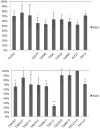Anti-Biofilm Activities from Marine Cold Adapted Bacteria Against Staphylococci and Pseudomonas aeruginosa
- PMID: 26696962
- PMCID: PMC4677098
- DOI: 10.3389/fmicb.2015.01333
Anti-Biofilm Activities from Marine Cold Adapted Bacteria Against Staphylococci and Pseudomonas aeruginosa
Abstract
Microbial biofilms have great negative impacts on the world's economy and pose serious problems to industry, public health and medicine. The interest in the development of new approaches for the prevention and treatment of bacterial adhesion and biofilm formation has increased. Since, bacterial pathogens living in biofilm induce persistent chronic infections due to the resistance to antibiotics and host immune system. A viable approach should target adhesive properties without affecting bacterial vitality in order to avoid the appearance of resistant mutants. Many bacteria secrete anti-biofilm molecules that function in regulating biofilm architecture or mediating the release of cells from it during the dispersal stage of biofilm life cycle. Cold-adapted marine bacteria represent an untapped reservoir of biodiversity able to synthesize a broad range of bioactive compounds, including anti-biofilm molecules. The anti-biofilm activity of cell-free supernatants derived from sessile and planktonic cultures of cold-adapted bacteria belonging to Pseudoalteromonas, Psychrobacter, and Psychromonas species were tested against Staphylococcus aureus, Staphylococcus epidermidis, and Pseudomonas aeruginosa strains. Reported results demonstrate that we have selected supernatants, from cold-adapted marine bacteria, containing non-biocidal agents able to destabilize biofilm matrix of all tested pathogens without killing cells. A preliminary physico-chemical characterization of supernatants was also performed, and these analyses highlighted the presence of molecules of different nature that act by inhibiting biofilm formation. Some of them are also able to impair the initial attachment of the bacterial cells to the surface, thus likely containing molecules acting as anti-biofilm surfactant molecules. The described ability of cold-adapted bacteria to produce effective anti-biofilm molecules paves the way to further characterization of the most promising molecules and to test their use in combination with conventional antibiotics.
Keywords: Polar bacteria; anti-adhesive; anti-biofilm molecules; anti-virulence; non-biocidal agents.
Figures




Similar articles
-
Anti-biofilm activity of the Antarctic marine bacterium Pseudoalteromonas haloplanktis TAC125.Res Microbiol. 2013 Jun;164(5):450-6. doi: 10.1016/j.resmic.2013.01.010. Epub 2013 Feb 11. Res Microbiol. 2013. PMID: 23411371
-
Anti-Biofilm Activity of a Long-Chain Fatty Aldehyde from Antarctic Pseudoalteromonas haloplanktis TAC125 against Staphylococcus epidermidis Biofilm.Front Cell Infect Microbiol. 2017 Feb 23;7:46. doi: 10.3389/fcimb.2017.00046. eCollection 2017. Front Cell Infect Microbiol. 2017. PMID: 28280714 Free PMC article.
-
Antibiofilm activity in the culture supernatant of a marine Pseudomonas sp. bacterium.Microbiology (Reading). 2020 Mar;166(3):239-252. doi: 10.1099/mic.0.000878. Microbiology (Reading). 2020. PMID: 31935186
-
Synthetic small molecules as anti-biofilm agents in the struggle against antibiotic resistance.Eur J Med Chem. 2019 Jan 1;161:154-178. doi: 10.1016/j.ejmech.2018.10.036. Epub 2018 Oct 17. Eur J Med Chem. 2019. PMID: 30347328 Review.
-
Recent advances in natural product-based anti-biofilm approaches to control infections.Mini Rev Med Chem. 2014;14(14):1169-82. doi: 10.2174/1389557515666150101095853. Mini Rev Med Chem. 2014. PMID: 25553429 Review.
Cited by
-
Antarctic Marine Bacteria as a Source of Anti-Biofilm Molecules to Combat ESKAPE Pathogens.Antibiotics (Basel). 2023 Oct 21;12(10):1556. doi: 10.3390/antibiotics12101556. Antibiotics (Basel). 2023. PMID: 37887257 Free PMC article.
-
Antimicrobial and Antibiofilm Activity and Machine Learning Classification Analysis of Essential Oils from Different Mediterranean Plants against Pseudomonas aeruginosa.Molecules. 2018 Feb 23;23(2):482. doi: 10.3390/molecules23020482. Molecules. 2018. PMID: 29473844 Free PMC article.
-
Anti-Virulence Properties of Coridothymus capitatus Essential Oil against Pseudomonas aeruginosa Clinical Isolates from Cystic Fibrosis Patients.Microorganisms. 2021 Oct 29;9(11):2257. doi: 10.3390/microorganisms9112257. Microorganisms. 2021. PMID: 34835383 Free PMC article.
-
Bacteriophages Promote Metabolic Changes in Bacteria Biofilm.Microorganisms. 2020 Mar 28;8(4):480. doi: 10.3390/microorganisms8040480. Microorganisms. 2020. PMID: 32231093 Free PMC article.
-
Marine Sponge-Derived Streptomyces sp. SBT343 Extract Inhibits Staphylococcal Biofilm Formation.Front Microbiol. 2017 Feb 16;8:236. doi: 10.3389/fmicb.2017.00236. eCollection 2017. Front Microbiol. 2017. PMID: 28261188 Free PMC article.
References
-
- Artini M., Cellini A., Scoarughi G. L., Papa R., Tilotta M., Palma S., et al. (2015). Evaluation of contact lens multipurpose solutions on bacterial biofilm development. Eye Contact Lens 41 177–182. - PubMed
-
- Bakermans C., Ayala-del-Río H. L., Ponder M. A., Vishnivetskaya T., Gilichinsky D. A., Thomashow M. F., et al. (2006). Psychrobacter cryohalolentis sp. nov. and Psychrobacter arcticus sp. nov., isolated from Siberian permafrost. Int. J. Syst. Evol. Microbiol. 56 1285–1291. 10.1099/ijs.0.64043-0 - DOI - PubMed
LinkOut - more resources
Full Text Sources
Other Literature Sources
Molecular Biology Databases

